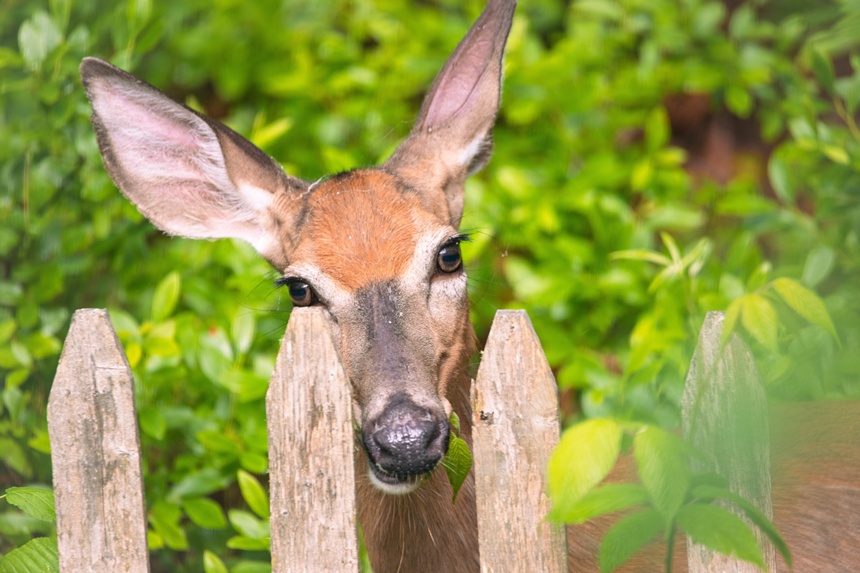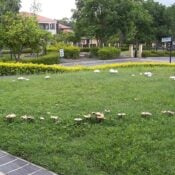If you like to garden, chances are you enjoy nature in general. Watching deer on a summer morning, for example, as they placidly browse leaves and shoots, can bring a sense of calm. Unless those leaves and shoots are growing in your garden.
Bugs that chew holes in cabbage leaves are one thing, but hungry herbivores can lay waste to rows of veggies in a single night. Once they find a tasty garden, they add it to their dining guide and will come back for more if you don’t stop them. While many species, including raccoons, chipmunks, squirrels, and birds, like to pilfer produce now and then, two in particular cause the most damage.
Anyone who’s seen Disney’s animated classic Bambi probably fell in love with the doe-eyed little hero and his energetic pal, a bunny named Thumper. Adorable as these animals are, in a garden they can undo a season’s worth of effort in a few days. Fortunately, the same tactics can get both deer and rabbits out of your vegetables and back into the wild where they belong.
White-tailed deer are found throughout the lower 48 states except California, Nevada, and much of Utah, but not all gardeners have issues with them. Deer are only a threat to gardens when their population density is high. The thing is, their numbers are up in general. According to Dr. Paul Curtis, professor of wildlife science at Cornell University, the white-tailed deer population jumped from an estimated half-million in the early 1900s to roughly 15 million today. Curtis says that given ample food, mild winters, and low predator numbers, their population can double in two to three years.
Deer also eat a lot, each day snarfing 3 percent of their body weight on average. Based on Dr. Curtis’s work, this translates to 4 to 10 pounds daily, depending on the deer’s size. That can put quite a dent in most gardens.
Another common garden visitor is the eastern cottontail, whose range extends from North Dakota south through Texas, and east to the Atlantic coast. Related species occur to the west, so the whole country has its fair share of bunnies.
Rabbits only live 12 to 15 months, but they make up for their short lives by breeding like, well, rabbits. With a gestation period of less than one month, they can have as many as six litters each year. At five to six babies per litter, it adds up fast. Bunnies are fond of things like parsley, basil, lettuce, and carrots, but eat the bark of woody shrubs, especially blueberries, often killing these plants.
The quickest fix is to use a repellent, something that smells and/or tastes bad to deer and rabbits. While you’ll find loads of commercial formulas on the market, there are three main types. One smells like rotten eggs, due to the fact it contains real “putrescent egg solids,” as the label will state. From experience, I’d say be careful not to spill it on you. Another option relies on capsaicin, derived from hot peppers, to teach Bambi and Thumper that your garden turned way too spicy all of a sudden. A third type uses “ammonium salts of fatty acids,” in other words, soap, to ward off critters.
Blood meal sprinkled around plants may help, as deer and bunnies are professional prey (in the eyes of predators), and don’t like the smell of blood. Be advised that blood meal is a fertilizer, and too much nitrogen isn’t good for some plants.
Home remedies abound, and often perform well, especially in small gardens. One tried-and-true method is to place strongly perfumed soap around the garden perimeter. Human hair from a hair salon or barber repels herbivores, too. There are other home-grown solutions, too – readers may want to share their favorites in the comments section.
The drawbacks to repellents are that they have to be reapplied every few weeks, as well as after heavy rains, and that animals will get accustomed to most ingredients over time.
Changing tack a moment, if space allows, gardeners and commercial growers sometimes plant a buffer strip of clover outside the garden to distract rabbits and deer, who love this plant. It sounds like putting your less-valuable jewelry outside to deter break-ins, but it often works.
The next level of critter control involves scare tactics. Since most marauders operate at night, motion-sensor lights will startle them and send them bolting. A string of flashing Christmas lights is ideal, as deer find the strobe effect particularly annoying. Reposition the lights once a week so deer don’t habituate to them. Taking it up a notch, a motion-activated sprinkler is said to be one of the best deterrents for deer, rabbits, squirrels, and most other garden-raiders. These units are found online or at garden centers.
Just as fake owls help deter birds, life-size coyote cutouts, available online, can be placed in and around a large garden to spook the deer. Change their locations every couple of days or the deer will figure out the ruse.
The renowned boxer Jack Dempsey is credited with saying, “The best defense is a good offense.” Well, the gold-standard defense against deer and rabbits is a good fence. A woven-wire galvanized fence is expected to last at least 20 years. To exclude rabbits, be sure the openings on the lower section of fence are no more than one inch square. Since deer don’t like enclosed spaces, smaller gardens (about 15 feet or less on a side) are usually safe with a 3- or 4-foot-high fence. Larger plots will require an 8-foot fence. It’s an investment that may be worth it for serious gardeners. Because ideally, you want to enjoy wildlife outside your garden.
Become a Saturday Evening Post member and enjoy unlimited access. Subscribe now




Comments
While living in Colorado 7000 ft up, I planted Marigolds around my small garden. Neighbor’s chickens would keep my garden free of insects & rabbits would only enter garden when it was under snow. Never had deer problems, too many large barking dogs in my country neighborhood.
A lot of good information with choices and methods of keeping rabbits and deer out of one’s garden. The best one will depend on the garden itself and other factors. I know a few people in Virginia and South Carolina this would help, and will forward it to them.
Hunting is the best solution.Venison and Rabbit are good to eat. Hard to beat a good Venison Steak or Burger if seasoned and cooked right. Whether fried or in stew, a good tender rabbit is hard to beat too. Fortunately where I live rabbits are always in season and with so many Deer around, seasons have been extended unless they’re on my property, then Deer season is always open. Yum!